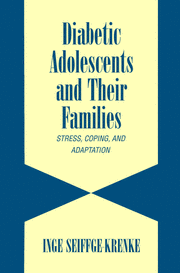Book contents
- Frontmatter
- Contents
- Foreword by Stuart T. Hauser
- Preface
- 1 Epidemiology of Chronic Illnesses in Adolescence
- 2 Coping with Illness in Adolescence: An Overview of Research from the Past 25 Years
- 3 Coping with Diabetes: A Longitudinal Study
- 4 Knowledge of the Illness, Compliance, and Patient–Physician Relationships
- 5 Self-Concept, Body Image, and Perceived Health
- 6 Adolescent, Parental, and Family Coping with Stressors
- 7 Chronic Illness and the Family: The Perspectives of Mothers, Fathers, and Siblings
- 8 Friendships, Romantic Relationships, School, and Career
- 9 Successful Adaptation or the Development of Psychopathology?
- 10 Pathways for Resolving the Dilemma between Developmental Progression and Adaptation to the Illness
- 11 Implications for Prevention and Intervention
- References
- Index
6 - Adolescent, Parental, and Family Coping with Stressors
Published online by Cambridge University Press: 06 August 2009
- Frontmatter
- Contents
- Foreword by Stuart T. Hauser
- Preface
- 1 Epidemiology of Chronic Illnesses in Adolescence
- 2 Coping with Illness in Adolescence: An Overview of Research from the Past 25 Years
- 3 Coping with Diabetes: A Longitudinal Study
- 4 Knowledge of the Illness, Compliance, and Patient–Physician Relationships
- 5 Self-Concept, Body Image, and Perceived Health
- 6 Adolescent, Parental, and Family Coping with Stressors
- 7 Chronic Illness and the Family: The Perspectives of Mothers, Fathers, and Siblings
- 8 Friendships, Romantic Relationships, School, and Career
- 9 Successful Adaptation or the Development of Psychopathology?
- 10 Pathways for Resolving the Dilemma between Developmental Progression and Adaptation to the Illness
- 11 Implications for Prevention and Intervention
- References
- Index
Summary
In this chapter the constructs of stress and coping will be discussed in greater depth, especially as they relate to the special circumstances of the adolescent suffering from chronic illness. Few concepts in health research have been as important, yet as difficult to define, as stress and coping. Lazarus et al. (1974), who have made substantial contributions to the field of coping research in adults, defined coping as
…problem-solving efforts made by an individual when the demands he/she faces are highly relevant … and tax his/her adaptive resources.
(p. 249)Inherent in this definition is the close association between stressors and coping skills.
Whereas early research initially concentrated on determining which features make an event stressful, the emphasis has shifted in recent times. Stressors are now seen as ubiquitous, and many researchers have come to believe that an individual's coping skills have a greater bearing on outcome, that is, adaptation or maladaptation, than the features of a stressor per se.
In the following, the kinds of stressors with which chronically ill adolescents are confronted will be described. In addition, the questions of how such stressors may accumulate is discussed. Finally, findings related to how adolescents and their families cope with these stressors during each phase of the illness are examined. As in the other chapters of this book, data obtained in our longitudinal study through questionnaires and interviews conducted with adolescents and their parents will be referred to.
- Type
- Chapter
- Information
- Diabetic Adolescents and their FamiliesStress, Coping, and Adaptation, pp. 84 - 117Publisher: Cambridge University PressPrint publication year: 2001
- 2
- Cited by



